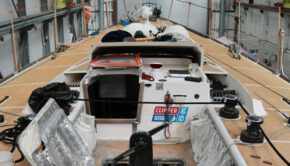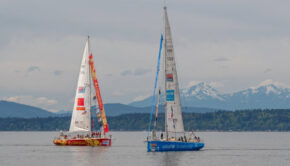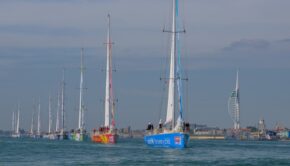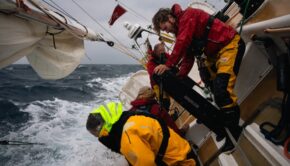Clipper Round the World Race: And they’re off
Published on September 1st, 2015
London, England (August 31, 2015) – The 12 international crews competing in the tenth edition of the world’s longest ocean race have started the 40,000 nautical mile circumnavigation off the English coast at Southend.
The Clipper Race, started at 12.30 UK time (GMT+1) in front of big crowds on Southend Pier. Race 1 sees the fleet racing 5,186 nautical miles to Rio de Janeiro, Brazil.
A cannon was fired by officials from Benfleet Yacht Club in the presence of Clipper Race Chairman and legendary sailor Sir Robin Knox-Johnston and Race Director Justin Taylor to mark the start of the 11-month long ocean odyssey.
LMAX Exchange, skippered by Olivier Cardin, was first over the line, followed by GREAT Britain, skippered by Peter Thornton close behind in second place, and Da Nang Viet Nam – led by Wendy Tuck – third over the start line.
Race Director Justin Taylor said: “It was a good clean downwind start with LMAX Exchange and GREAT Britain well practiced when launching their spinnakers very quickly.
“Qingdao came through very fast too, and is now in third position as a result. I predict they will be off Ushant in the north west corner of France in 60 hours.
“Good luck to them all at this exciting time, and we will see them in Rio.”
Sir Robin said: “Watching the crews start their adventure is a very special moment after all the months, and in many cases, years of training and preparation they have undertaken to get to this stage.
“The challenges that lie ahead are going to test them to their limits physically and mentally, and they are going to need to work as a team to overcome everything Mother Nature will throw at them.
“They are going to change their lives forever by competing in this ocean adventure. I wish them fair winds and competitive but safe sailing as they circumnavigate the globe,” added Sir Robin, 76, who became the first person to sail solo non-stop around the world in 1968-9.
The Race Start follows a spectacular Parade of Sail by the fleet of ocean racers down the River Thames yesterday. Tens of thousands of well-wishers filled the international Race Village and lined the banks of the Thames to wave off the 12 courageous crews and their professional Skippers.
London’s Tower Bridge lifted to salute the crew twice ahead of their race adventure.
The opening leg of the race takes the teams over 5,000 nautical miles from the British capital, across the Atlantic Ocean, including the challenging Doldrums, to Rio de Janeiro, Brazil.
The fleet will be starting in light to moderate conditions of 8-10 knots of wind from generally north as they travel south on a deep run from the Thames Estuary.
The wind will pick up a little more into the low teens, gusting a little more occasionally, down the English Channel, according to Simon Rowell, the Clipper Race meteorologist .
The fleet will face the likelihood of more north to north west winds to pass Ushant at the North West corner of France. Then the notorious Bay of Biscay must be swiftly crossed, with a favourable forecast hopefully giving the fleet a fast passage to Cape Finisterre.
Skippers will then be watching for developing incoming low pressure systems heading across the Atlantic Ocean.
The Canary Islands are on the direct route to Rio. The decision whether to leave them to the east, sail through the middle or pass on the west delivers a major tactical headache. Get it wrong and you are caught in the wind shadow of the huge mountains that extend for more than 100 miles out to sea.
Spinnakers are likely to be set for as much as two weeks on this leg. The spinnakers have to last another 40,000 nautical miles, so it’s a fine balance between pushing hard in the early stages and risk suffering damage to kit or taking it too easy and missing a podium place.
Next up is the dreaded Doldrums (Inter Tropical Convergence Zone), where wind holes, squalls, humidity and unpredictable conditions will try the patience of even the most stoical crew members. And a visit to the Court of King Neptune as crews cross the Equator and go from the Northern to the Southern Hemisphere is a highlight of the leg.
Dual nationality Brazilian and Dutch Unicef crew member Eduard Braga Rettich will be sailing into Rio for the first time on Race 1. He said: “The race is going to be a very big and demanding challenge with a lot of lows and highs. To get into the bay of Guanabara will be wonderful with friends and family waiting for me there.”
Following the first stopover in Brazil, the fleet will continue on via Cape Town, Albany – Western Australia, Sydney (including the world famous Sydney-Hobart Race), the Whitsundays, Da Nang – Vietnam, Qingdao – China, Seattle, Panama, New York, Derry-Londonderry and Den Helder – the Netherlands, before returning to London’s St Katharine Docks for Race Finish on 30 July 2016.
Event Website
Report by event media









 We’ll keep your information safe.
We’ll keep your information safe.